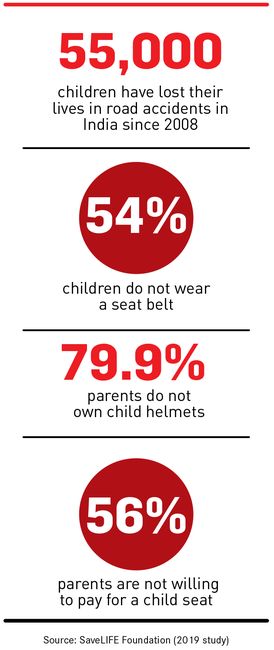Blanket? Check. Snacks? Check. Toys? Check. Promethazine? Eh? Avomine tablet! Ah, check.
No, this is not a pre-flight checklist for a trans-Atlantic trip. It is a checklist for a two-hour drive on Indian roads with my three-year-old daughter. When my husband drives, she, at times, would want to sit in front, on my lap—a safety hazard on many levels, especially so because airbags are dangerous for children. Even when she is seated in the back with the seatbelt on, I am worried, because that, too, is not the safest position for a toddler.
Unlike most developed nations, India does not have strict guidelines for travelling with a toddler in a car or on a bike. It is not mandatory to install a child safety seat. Many times, children are seated on the laps of adults, in front and back seats. Why so? Most kids like it that way, and then there is the advantage of being able to accommodate more people! While the question of over-crowded vehicles is a discussion for another day, children on adults’ laps means putting the child in harm’s way.
So, this gets one thinking—are road safety laws letting our children down? Children riding pillion on bikes and scooters is a common sight in India, and those children are almost never wearing helmets.
According to a study by the NGO SaveLIFE Foundation, more than 55,000 children have died in road accidents in India since 2008. What’s more, close to 76 per cent of parents in India are not aware of their vehicles’ child restraint systems, and only 20 per cent of parents own child helmets.
Every day, more than 30 children die in road crashes, said Piyush Tewari, CEO and founder of SaveLIFE Foundation. “It is a significant challenge that needs to be addressed…. Adults accompanying children should be penalised more, if they violate a traffic regulation. This will ensure the child’s safety.”
And, it seems the government is keen to make amends. Last month, the Union ministry of road transport issued a draft notification by revising the existing Motor Vehicles Act. It mentioned safety measures to be taken by bike and scooter riders with co-passengers below four years of age. Henceforth, children aged between nine months and four years will be under the jurisdiction of the amended Motor Vehicles Act. According to the rule, children must wear ISI-certified helmets, and the speed limit is set at 40kmph. The burden of compliance is on the parent/ adult accompanying the child.
Once passed, these rules will be applicable from 2022. But what about cars? Children, especially below the age of 12, tend to move around a lot in a car, which can result in them being gravely injured, if the vehicle meets with an accident. Moreover, airbags have been proven to be hazardous for kids below age four. Airbags inflate forcefully at a speed of 322kmph or within 1/20th of a second, which can cause serious injuries to a toddler.
Keeping a small toddler on one’s lap is not a good option as there is risk of the child being injured during hard braking, said Dr Shankar Vishwanath, honorary traffic advisor to Mumbai Police. “Parents must ensure that children, up to the age of seven, sit in child seats while travelling in the car,” he said.
A few overseas Indians that THE WEEK spoke to said that the attitude towards child safety on Indian roads was careless.
Child safety is the missing block that everybody seems oblivious to, said Prahlad Balagopal, a mechanical engineer in Singapore. “Making the child sit on an elder person’s lap or even in the seat with a standard seatbelt across their necks are horrors that play out. It is quite understandable for parents or grandparents to have the desire to hold the new bundle of joy in their laps while travelling, but the indefinable tragedy that could unfold in the event of a collision is dismissed,” he said.
US-based Divya Anand, a mother of two, said, “Car seats for children should be made mandatory in India, and children should be prevented, by law, from sitting in the front seat of any vehicle. This will go a long way towards ensuring the safety of children.”
Indians living in various parts of the world are seen to take road rules seriously and abide by them, said Suja Karthika, a professor at Hong Kong Metropolitan University. “But in our country since the price to pay is not relevant, people just don’t seem to bother,” she said. “Once things are legitimised, and people follow it as a rule with high penalty, then slowly it will become a way of life. If Indians can wear masks and make it a part of their wardrobe in a matter of days, changes like this can be easily implemented.”
In September 2019, a one-year-old baby in Kerala fell from a moving car. Thankfully, the child was unharmed and was rescued by officials nearby. But the scene certainly paints a grim picture of child safety on Indian roads. Ensuring that the child-lock is on, driving at a safe speed and being vigilant are simple things that can be done to ensure the safety of children.



